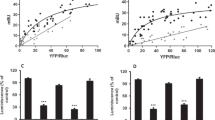Summary.
Neurotransmitter release is modulated by presynaptic histamine H3 receptors located on histaminergic, noradrenergic and other nonhistaminergic neurons of the central and peripheral nervous system. Here, we report the determination of the structure of the human histamine H3 receptor gene (HRH3) and the identification of a missense mutation (Ala280Val) in a patient with Shy-Drager syndrome. The coding region of the gene consists of three exons interrupted by two introns of approximately 1 kb in size. Exon boundaries only partly correspond to transmembrane domain organization. The homozygous Ala280Val variation in the third intracellular loop of the histamine H3 receptor of a patient with Shy-Drager syndrome may be related to the etiology of the illness due to altered norepinephrine release. Furthermore, knowledge of the gene structure allows the verification of alternative splicing of the receptor. The corresponding histamine H3 receptor isoforms as reported for the guinea pig and rat histamine H3 receptor in different brain regions are not found in the human brain.
Similar content being viewed by others
Author information
Authors and Affiliations
Additional information
Received July 11, 2001; accepted November 30, 2001
Rights and permissions
About this article
Cite this article
Wiedemann, P., Bönisch, H., Oerters, F. et al. Structure of the human histamine H3 receptor gene (HRH3) and identification of naturally occurring variations. J Neural Transm 109, 443–453 (2002). https://doi.org/10.1007/s007020200036
Issue Date:
DOI: https://doi.org/10.1007/s007020200036




